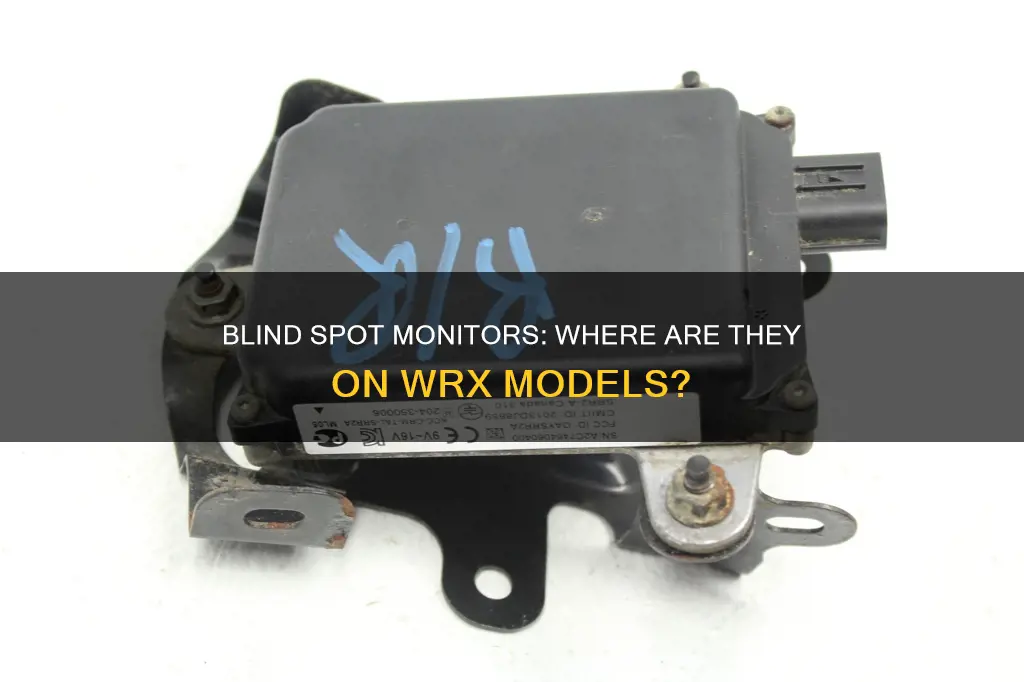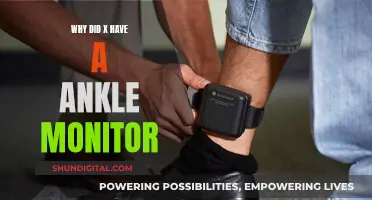
Blind-spot monitors are an important safety feature in vehicles, providing drivers with critical support by alerting them to vehicles or objects outside their field of vision. While some Subaru WRX models have built-in blind-spot detection, others do not, and drivers have sought aftermarket solutions to enhance their driving awareness and safety. This has sparked discussions among WRX owners about the effectiveness of blind-spot monitors, with some expressing confusion over the placement and design of the indicators, and others sharing their positive experiences with aftermarket options. The process of installing aftermarket blind-spot monitors involves placing sensors and indicators, and while professional installation is recommended, it is possible to do it yourself.
| Characteristics | Values |
|---|---|
| Blind spot monitoring system | Subaru Blind Spot Detection |
| How it works | Employs a set of sensors including radar and cameras, often positioned on the mirrors and/or rear bumper |
| When to use | When another vehicle enters the blind spot area |
| How it alerts the driver | Blinking light on the corresponding side mirror, sometimes accompanied by a beeping or clicking noise |
| Control | Can be disabled by toggling a switch located in the dash area and/or on the infotainment screen |
| Similar features | Rear Cross-Traffic Alert |
| Sensor technologies | Sonar, radar, lidar |
What You'll Learn

Blind spot detection and turn signals
Blind spots are areas outside a driver's field of vision, which can be hard to see even when using mirrors. Blind Spot Detection (BSD) is a safety feature in some modern cars that helps drivers be aware of vehicles or objects in their blind spots. This is achieved through the use of sensors, cameras, and alerts.
The 2022+ Subaru WRX is one such car that has BSD as a feature. However, some drivers have reported confusion between the turn signal indicators and the blind-spot-warning lights, which are both embedded in the exterior mirrors. This has led to some drivers being unsure if the indicator in the mirror is signalling a lane change or warning of a vehicle in their blind spot.
To distinguish between the two, it is important to note that the turn signal light will flash at a normal cadence, while the blind spot monitoring system will flash much more rapidly. Additionally, when looking at the driver's side mirror from inside the car, you can see part of the turn signal light housing on the left side of the mirror, and the blind spot monitoring system on the right side.
While BSD can be a helpful feature, it is important to remember that it should not replace the act of physically checking one's blind spots. Aftermarket BSD kits are available for cars that do not have this feature built-in, but professional installation is recommended.
Monitor Bezel Blind Spots: Understanding the Unseen
You may want to see also

OEM blind-spot detection mirrors
Blind-spot detection mirrors are an incredibly useful tool for drivers. Many modern cars provide tools that increase a driver's awareness of their surroundings. Some cars come preinstalled with backup cameras, collision alert systems, and more, but there isn't a standardized solution to reducing blind spots while on the road.
An aftermarket blind-spot monitor is a perfect addition if you own an older vehicle that is not equipped with certain types of technology. Aftermarket blind-spot monitoring systems are not as common as factory-installed systems, but they continue to expand as more companies jump into the market. These companies offer custom-designed kits geared toward a variety of vehicles.
Blind-spot detection mirrors are an option for those who want to avoid the hassle of installing an aftermarket blind-spot monitoring system. Blind-spot detection mirrors are an incredibly useful and affordable safety accessory. On average, most blind-spot mirrors are around or under $10. When considering any blind-spot mirror, you want to account for positioning on your side mirrors along with the shape of the blind-spot mirror to ensure you're getting the right-sized mirror for your vehicle.
The UtopiCar Blind Spot Mirror is designed to look like an original equipment manufacturer (OEM) part. The UtopiCar mirror is frameless to give you the largest field of vision possible. Images on this mirror appear three times larger than the average blind-spot mirror, ultimately making it easier to see what's in your blind spots. The UtopiCar Blind Spot Mirror is one of the best mirrors on the market for increasing your field of view.
Another option for an OEM-style blind-spot detection mirror is the Marlbston Blind Spot Mirror. This mirror is a universal fit as it's designed to work on a variety of different vehicle types, including cars, motorcycles, SUVs, and even golf carts. This adjustable blind-spot mirror has a 360-degree swivel rotation and 30 degrees of sway to provide the driver with a wide angle of view. The Marlbston Blind Spot Mirror is the best overall blind-spot monitoring system due to the increased level of visibility it provides and the number of accessories it comes with.
In conclusion, blind-spot detection mirrors are a great option for those looking to increase their field of view while driving. They are affordable, easy to install, and provide increased visibility and safety for drivers.
LCD Monitor Conditioning: What, Why, and How?
You may want to see also

DIY blind spot detection
Blind spots can be a pain, especially when you're driving a car like the WRX. While the 2022+ Subaru WRX does have built-in blind-spot detection, some drivers have reported issues with confusing the turn signal indicators with the blind-spot warning lights. So, what can you do if you're looking for a DIY solution to improve your blind-spot detection? Here are some ideas and tips from other drivers and enthusiasts:
Wide-Angle and Convex Mirrors
A simple and cost-effective solution is to use wide-angle or convex mirrors, which can be stuck onto your existing side mirrors. These mirrors give you a wider field of view, reducing the size of the blind spot. Some people even recommend using interior rear-view convex mirrors for an even better experience. You can find these mirrors online or at most auto parts stores.
Blind Spot Detection Kits
If you're looking for a more high-tech solution, you can try installing a blind spot detection kit. These kits typically use ultrasonic sensors to detect objects in your blind spot and provide an indication through lights or sounds. You can find these kits on Amazon or other online retailers, and they can be installed as a DIY project. However, keep in mind that some kits may require additional components, such as a laptop with specific software or a 3D-printed case for the sensors.
OEM Blind-Spot Detection Mirrors
For a more integrated solution, you could consider installing OEM (Original Equipment Manufacturer) blind-spot detection mirrors on your WRX. However, this option may be more complex and expensive, as it requires additional sensors, wiring, and calibration. It might be challenging to find the right mirror plastics to house the blind spot indicators, and you may need to visit a body shop or dealer for proper calibration.
Arduino-Based Solutions
If you're feeling adventurous and have some technical skills, you can try building your own blind spot monitoring system using an Arduino UNO or similar microcontroller. You'll need components like an ultrasonic sensor, an RGB LED strip, and a laptop with the Arduino IDE installed. There are online guides and YouTube videos that can help you through the process of building and programming your own blind spot detection system.
Remember, while these DIY solutions can enhance your blind-spot detection, they should not replace proper driving techniques, such as checking your mirrors and turning your head to look for vehicles in your blind spots. Stay safe on the road!
Repairing Dead Pixels on an LCD Monitor: A Step-by-Step Guide
You may want to see also

Aftermarket blind spot monitors
Blind-spot monitoring is an essential safety feature in modern cars, and while it is a standard feature on many new vehicles, it is not present on all models, especially older ones. Aftermarket blind-spot monitors are an excellent option for those who want to add this safety feature to their car.
Benefits of Aftermarket Blind Spot Monitors
- Increased driving awareness: These systems provide extra coverage by constantly monitoring spots outside the vehicle that the driver may not be able to see, thus improving overall driving awareness.
- Assistance for larger vehicles: Driving larger vehicles can be challenging due to limited visibility. Blind spot monitors reduce the stress of driving by providing a view of the unseen areas around the vehicle.
- Crash prevention: By tracking the areas around the vehicle, blind spot monitors help prevent crashes with other vehicles in the same or adjoining lanes.
- Improved response time: Blind spot monitors are often more accurate than mirrors, allowing drivers to identify potential dangers faster and react accordingly by braking or steering.
Types of Aftermarket Blind Spot Monitors
Aftermarket blind spot monitoring systems are typically designed as custom kits for various vehicles. They may include features such as:
- Sensors: These use technologies like sonar, radar, or lidar to detect hazards in the vehicle's exterior environment. Some sensors are integrated into side mirrors and relay information to a computer.
- Indicators: This component alerts the driver when the sensor detects a hazard. Indicators can be visual, like LED lights, or audible, like an alarm. Some systems offer both types of indicators for added safety.
Installation of Aftermarket Blind Spot Monitors
While professional installation is recommended for aftermarket blind spot monitors, it is possible to install them yourself with some technical know-how. Here are the general steps:
- Calibration: Place a calibration cloth behind the vehicle, aligning it with a measuring tape at a 90-degree angle. Use a level to ensure it is vertical, then mark a straight line on the rear bumper.
- Bumper removal: Remove the rear bumper and, if necessary, the taillights. Clean the calibrating positions in the inner rear bumper with a cleaning cloth and rubbing alcohol.
- Sensor placement: Place two magnets on the marked lines, one on the outside and one on the inside, attracting each other. Adjust the sensors to a 20-degree angle from the bumper.
- Adhesive and mounting: Apply adhesive to the sensors and stick them to the inside of the bumper. Mount the LED indicators inside the cabin, ensuring they are visible without obstructing the driver's view.
- Volume adjustment: Test the system and adjust the volume to ensure it is audible without being startling.
Monitoring Power Usage: RV Hookup Management
You may want to see also

Subaru blind spot detection
Blind Spot Detection is a feature available on many Subaru models, including the WRX, and is standard on certain trims. This innovative safety feature provides drivers with critical support where they need it most: in areas they cannot see.
Subaru's Blind Spot Detection system employs a set of sensors, including radar and cameras, often positioned on the mirrors and/or rear bumper. These sensors constantly monitor adjacent lanes and nearby objects relative to a driver's designated blind spot zone. When another vehicle enters this area, the sensors detect it and trigger an alert, such as a blinking light on the corresponding side mirror or an auditory cue. This warning lets the driver know to use added caution when shifting lanes or merging.
The system can be disabled by toggling a switch located in the dash area and/or on the infotainment screen. Additionally, in many Subaru models, the Blind Spot Detection system works in conjunction with a similar feature called Rear Cross-Traffic Alert, which can be controlled using the same switch or touchscreen toggle.
While Blind Spot Detection is a valuable feature, it is important to remember that it should not replace the driver's responsibility to check their blind spots manually and use mirrors properly. Aftermarket blind spot monitors are also available for older vehicles that may not have this technology built-in. These systems can increase driving awareness, assist drivers of larger vehicles, prevent crashes, and increase response time.
The Hunt for CRT Monitors: Where to Look?
You may want to see also
Frequently asked questions
The blind spot monitoring system in the WRX employs a set of sensors, including radar and cameras, often positioned on the mirrors and/or rear bumper. These sensors constantly monitor adjacent lanes and nearby objects relative to a driver’s designated blind spot zone.
Blind Spot Detection is available on many Subaru models and standard on certain trims, including the 2022+ Subaru WRX.
Yes, you can install an aftermarket blind spot monitoring system. However, professional installation is recommended.







